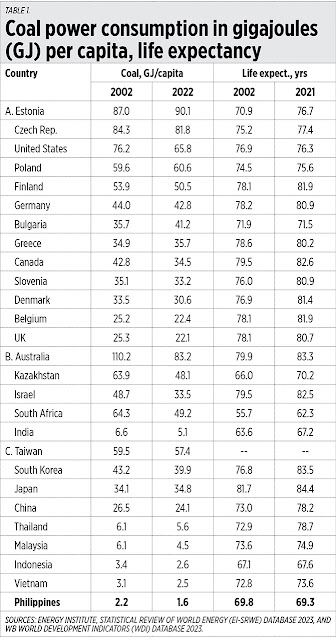Coal power and higher life expectancy
January 30, 2024 | 12:02 am
My Cup of Liberty
By Bienvenido S. Oplas, Jr.
https://www.bworldonline.com/opinion/2024/01/30/571835/coal-power-and-higher-life-expectancy/
AMONG the common arguments against the retention of existing coal power plants in the Philippines and other countries is that coal is polluting and causes more sickness, lowering lifespans.
I intend to verify and quantify how honest or dishonest this statement is. For international data, I got the total coal consumption (in exajoules, EJ) by country, then divided it with their population in a given year, then I computed the coal consumption in gigajoules (GJ) per capita. I divided the countries into three. In Group A are the countries in Europe and North America, in Group B are selected Asia-Pacific countries plus South Africa, and in Group C are East Asian countries. The results:
1. Many countries in Group A had huge coal consumption until 2022. “Greenie” Germany had 43 GJ/capita, the US had 66, and Estonia had 90. In Group C, Indonesia had only 2.6 GJ/capita, Vietnam had 2.5, and Philippines had only 1.6. Yet the Philippines and other Asians are being bullied constantly to retire their coal plants soon — and prepare for blackouts and underdevelopment.
2. Despite repeated mantras of “decarbonization” and “exit from coal,” coal per capita consumption has generally been flat over the past two decades in many countries including greenie Europe and North America.
3. Countries with high coal consumption per capita also have long life expectancies of up to 82 years (Canada, Finland, Belgium). So there is no truth that as countries consume more coal power, their sickness incidence is high and life expectancy is low. It is a dishonest narrative (see Table 1).
The Philippines should expand our coal capacity, which is very small on a per capita level compared to greenie countries in the West. But there is endless bullying to decommission many of our coal plants, and opposing the expansion of existing ones, like the proposed coal expansion in Toledo, Cebu, partly on health grounds.
I computed the coal capacity per capita in some provinces in the Philippines. These are Bataan, Quezon, Batangas, and Pangasinan (see Table 2).
Bataan’s coal capacity per capita is 17 times larger than Cebu’s, Quezon’s is six times larger than Cebu’s. Are the people in Bataan and Quezon more sickly, dying faster, than the people in Cebu, or in provinces with no coal plants like the Cordillera and Cagayan regions, the Bicol region, the Negros provinces? Far out.
The Department of Energy (DoE) and other government agencies, national and local, should ignore the infantile concerns of the anti-coal groups based on dishonest health claims. The DoE should also consider allowing coal plants in greenfield investment while nuclear power development is still being discussed. Help enable the economy to have cheap and stable electricity, and help sustain fast growth.
UPSE RPA-PDEAA LECTURE
The University of the Philippines School of Economics (UPSE) Program in Development Economics Alumni Association (PDEAA) will hold the second annual Ruperto P. Alonzo (RPA) lecture on the topic, “The nuclear option and economic growth” on Feb. 8, Thursday, 3 p.m., at the UPSE in Diliman, Quezon City. It will be open to the public and media.
The main speaker will be DoE Undersecretary Sharon Garin, and the panel discussants will be Irma Exconde (PDE batch 37); Dr. Carlos Arcilla of the Philippine Nuclear Research Institute (PNRI); a physicist, Paolo Pagaduan, of the Asian Peoples’ Movement on Debt and Development; and representatives from Aboitiz Power (AP) and MGen/Meralco. The moderator will be Jay Layug, an UPSE alumnus.
Sponsors of the event are AP, Meralco, and Robinsons Retail Holdings, Inc.
It will be good to hear from the only energy companies in the Philippines which have explicitly declared their intention to develop nuclear energy in their future power portfolio. Robinsons, in the meantime, is one of the biggest power consumers in the country because of their many business units.
--------------
See also:
BWorld 674, Nuclear energy and the UPSE RPA-PDEAA lecture, January 24, 2024
BWorld 675, Declining births, rising deaths, and economic damage, February 01, 2024
BWorld 676, My Economic Forecast for 2024 – 6.5%, February 10, 2024.


No comments:
Post a Comment